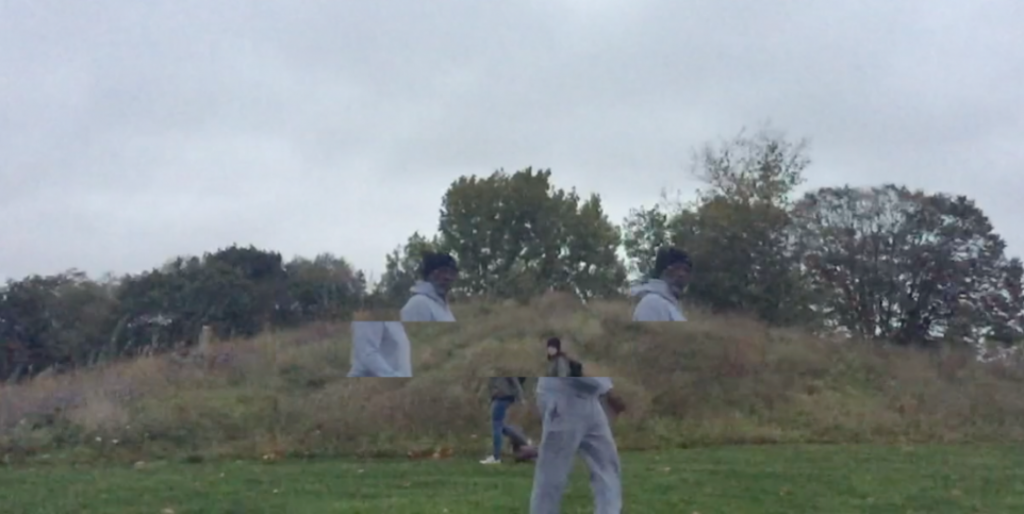I find the idea of performing to a lack of audience very interesting. Perhaps it stems from a personal fear of doing anything with an audience or how I miss the feeling of not being under constant surveillance when growing up rurally, butthe idea of performing and giving something to your surroundings rather than a sentient audience is one that I’d like to explore.
In a lecture last week, I was introduced to the work of Richard Long, who in the 60s used to travel out to rural areas and create works such as ‘A Line Made By Walking’, ‘England’ and ‘Walking A Line in Peru’. (see below).

Richard Long, A Line Made By Walking, 1967 (1)

Richard Long, England, 1968 (2)

Richard Long, Walking A Line in Peru, 1972 (3)
It’s similar to minimalist sculpture and indeed he did call it a sculpture, yet it exists only as a photograph, a record of the temporary impression he made in the ground. Similarly, his piece ‘Ben Nevis/Hitch-Hike’ exists now only as a set of photographs of the sky and ground paired with a map. That is now the piece. Long’s work ties into the idea of art as form versus art as idea, with form merely being a vehicle for presentation. The act of doing was the real piece, and there’s something beautiful about art being so temporary. Gabriel Orozco’s work ‘Extensions of reflection’ also focused on this sense of temporality. The photographs he took (see below) of breath on a piano or wet tire tracks protruding out of a puddle for ‘Extension of Reflection’, for example, aren’t the primary thing that we’re viewing. What we’re asked to enjoy is the fact that these are ephemeral, spontaneous gestures lost in the world but recorded for us to view.

Gabriel Orozco, Extension of Reflection, 1992 (4)

Gabriel Orozco, Breath On Piano, 1991 (5)
Francis Alys’ piece ‘The Loop’ is another example of this. The Belgian artist, who “uses poetic and allegorical methods to address political and social realities, such as national borders, localism and globalism, areas of conflict and community, and the benefits and detriments of progress” (6), undertook the process of travelling from Tijuana, Mexico to San Fransisco, America without crossing the border between the two. However, what remained of this ambitious and heavily political journey for the audience to experience was a mere postcard. Of course, the postcard itself as an object isn’t the work, but the clearest and most relevant way to display the artist’s actions. It’s his idea and the event that followed that was the work, the postcard merely being a way to explain it.


Last year, I also came across the video work of a young German artist, whose name I have since lost. One of her pieces consisted of filming herself, from behind, alone in a field wearing a white biohazard suit and dancing to a herd of deer. It was quite surreal as a viewing experience, watching her carry on relentlessly to this un-reacting audience. However, because she filmed it and is now displaying it at least online, does that allow the deer to become the main audience? Or do they become props for the human viewer to consume second-hand? This idea of having to clearly document something to solidify it as a ‘happening’ is one that interests me greatly.
This is something I want to explore myself. The Polish Theatre Director Gratowski, who was inspiration for Joachim Koester’s film ‘Maybe One Must Begin With Some Particular Places’, used to create intersections of performance, anthropology and ritualism by taking his actors out into rural areas and making them do audience-less performances, with only the landscape watching them. (7) I would like to do something similar, by staging an audience-less wrestling match in a remote location. At the moment I’m thinking of filming it but with the camera facing the other way. The sound would act as evidence but the performance itself would be lost, viewed only by the surrounding landscape. I want the audience to be as unknowing of the event happening in front of them as the land would have been, with the video serving not as the piece but a mere record of the piece. As a record, does it have to show everything?
(1)http://www.richardlong.org/Sculptures/2011sculptures/linewalking.html
(2)http://www.richardlong.org/Sculptures/2011sculpupgrades/england.html
(3)http://www.richardlong.org/Sculptures/2011sculptures/lineperu.html
(4,5)http://www.tate.org.uk/context-comment/articles/now-ever-again
(6)https://www.moma.org/calendar/exhibitions/1091?locale=en
(7) Koester, J., (2015) Joachim Koester: Of Spirits and Empty Spaces, London: Mousse Publishing.
